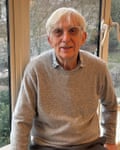MY BEST SHOT
Samuel Beckett smoking a French cigarette: John Haynes’s best photograph
‘One day, I was summoned to a pub near the Royal Court theatre where Samuel Beckett was looking at my work. “These are wonderful pictures,” he said’
Wed 27 Nov 2024 15.39 GMT
Iknew Samuel Beckett’s reputation. He didn’t like photographers. He didn’t want them around really. It’s hard to believe I took so many photographs of him. During the 1970s, I photographed him and his rehearsals at the Royal Court theatre in London, and eventually did a book with his biographer James Knowlson called Images of Beckett. In 2015 my photographs of him and his plays were projected on to the chapel of King’s College Cambridge as part of its 500th anniversary celebrations. It’s been a long, unexpected association.
I remember taking Beckett’s portrait in 1973. I was absolutely petrified of the man. It was just me and him on the Royal Court stage, completely empty apart from the one chair he was sitting on. It was like being in one of his own plays. He was wearing sunglasses. Everything was black right down to the fur collar of his coat, except for the light on his lap.
Maybe my nervousness helped. I’m sometimes so nervous I might take three or four pictures where others might take one. I took some photos of him as he sat there, not talking very much. I always try not to pose people whose portraits I’m taking, just capture them in whatever they’re doing. Then I asked him to take the sunglasses off and he looked straight at the camera with those incredibly piercing eyes. My photograph of that is reproduced a lot.
But the picture of him I love most is this – another of him in profile. I took it in the same year: he was directing Billie Whitelaw in Not I at the Royal Court. By then I’d been in-house photographer for three years. Beckett was standing in front of the stage talking to Billie and, as they talked, they moved around in a kind of dance. And I kind of danced around them too, snapping away. There’s something about that little French cigarette he’s puffing on, the way he’s holding it with his fingers and the intensity of his expression. Also, everything’s black, even his turtleneck, so there’s nothing to look at but his profile.
I started taking photographs in 1963 with a secondhand Leica. I’d come back from doing military service in Singapore and didn’t know what to do with my life. I saw Henri Cartier-Bresson’s book The Europeans. I thought: “Wow! This guy takes photographs, but they’re not just ordinary snaps.” They were compositions. Everything was just right, even the details in the background. He called them “decisive moments” and they were. I fell in love with his work and thought: “I’ll try to do that.”
Something different happened with Beckett. I know he liked my work. I once made a montage of six photographs of Billie Whitelaw in Footfalls [which Beckett directed at the Royal Court in 1976; Whitelaw played a woman compulsively pacing up and down a narrow strip of stage in communion with her unseen mother]. I photographed her just pacing back and forth, and in one photograph you see her screaming with a great big open mouth. Jim Knowlson told me that was Beckett’s favourite picture.
Something different happened with Beckett. I know he liked my work. I once made a montage of six photographs of Billie Whitelaw in Footfalls [which Beckett directed at the Royal Court in 1976; Whitelaw played a woman compulsively pacing up and down a narrow strip of stage in communion with her unseen mother]. I photographed her just pacing back and forth, and in one photograph you see her screaming with a great big open mouth. Jim Knowlson told me that was Beckett’s favourite picture.
One day I was summoned to the pub next to the Royal Court. Beckett was there with the PR. They were going through a sheet of contacts, including one of Beckett and Whitelaw gesticulating at each other during a rehearsal of Footfalls. He said to me: “These are wonderful pictures.” I just reeled away, thrilled. That was enough.
A Life Passing By: Photography by John Haynes from 1963 to the Present Day is at 3 Avenue Studios, Sydney Close, London, until 6 December. By appointment only. Email contact@nbbtrading.com to arrange a viewing
John Haynes’s CV

Born: London, 1937
Training: Self-taught
Influences: “Henri Cartier-Bresson. I was also mentored by the Sunday Times picture editor, Steve Brodie, who gave me my first commission: to photograph a wet fish shop in Waterloo. The photograph made it to the front page of the paper.”
High point: “In 1970 I became the resident photographer for the Royal Court, which led to me photographing Beckett’s plays.”
Low point: “Having my rehearsal photographs of Life Class in 1974 ripped up by the director, Lindsay Anderson. I survived though, and stayed on to photograph all Anderson’s subsequent productions.”
Top tip: “You need to have a passionate engagement with the subject. To quote Cartier-Bresson, ‘Composition should be a constant companion.’ It’s not about buying lots of equipment. I did my first job for the Sunday Times with one camera and two lenses.”


No comments:
Post a Comment